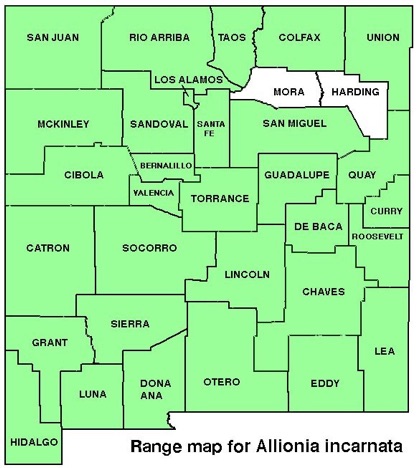WILDFLOWERS OF NEW MEXICO

Low, sprawling stems trail 1–3 feet from the root crown. Often grains of sand adhere to the hairy, sticky stalks and leaves. The delicate magenta flowers seem out of place in the harsh sandy, rocky environment. Note the showy bloom consists of three separate flowers clustered together.
FLOWERS: April–September. Look closely at the rose to magenta flowers. Three clustered flowers resembling a single flower make up the 3/16–1 inch wide (5–25 mm) bloom. Each bilaterally-symmetrical flower opens into a single, fan-shaped petal deeply cut into 3 long, notched lobes; stamens long and pink with yellow anthers. The mature seeds have curved ribs with 0–4 slender teeth.
LEAVES: Opposite, uneven. Blades sticky, paired, oblong with stems (petioles) equal or shorter than the blades, uneven at the base, flat to wavy margins, and reduced in size up the stem. Larger leaves are 3/4–2 1/2-inches long (20–65 mm) and 3/8–1 3/8-inches wide (10–35 mm).
HABITAT: Gravelly, sandy, clay soils, disturbed areas, roadsides; desert scrub, pinion-juniper woodlands.
ELEVATION: 3,000–7,400 feet.
RANGE: AZ, CA, CO, NV, NM, OK, TX, UT.
SIMILAR SPECIES: Two varieties in NM. Variety incarnata has small (3/8-inch wide.) flower clusters; var. villosa large (1-inch wide) clusters. The annual A. choisyi has a similar range, is nearly identical, and sometimes lumped with A. incarnata.
NM COUNTIES: Statewide, except Mora and Harding counties, in low- to mid-elevation, dry habitats.









TRAILING FOUR-O’CLOCK, TRAILING WINDMILLS
ALLIONIA INCARNATA
Four-O'clock Family, Nyctaginaceae
Perennial herb
THE CONTENTS OF THIS WEBSITE ARE COPYRIGHTED AND CANNOT BE USED
WITHOUT PERMISSION OF GEORGE OXFORD MILLER




















































EMAIL ME







